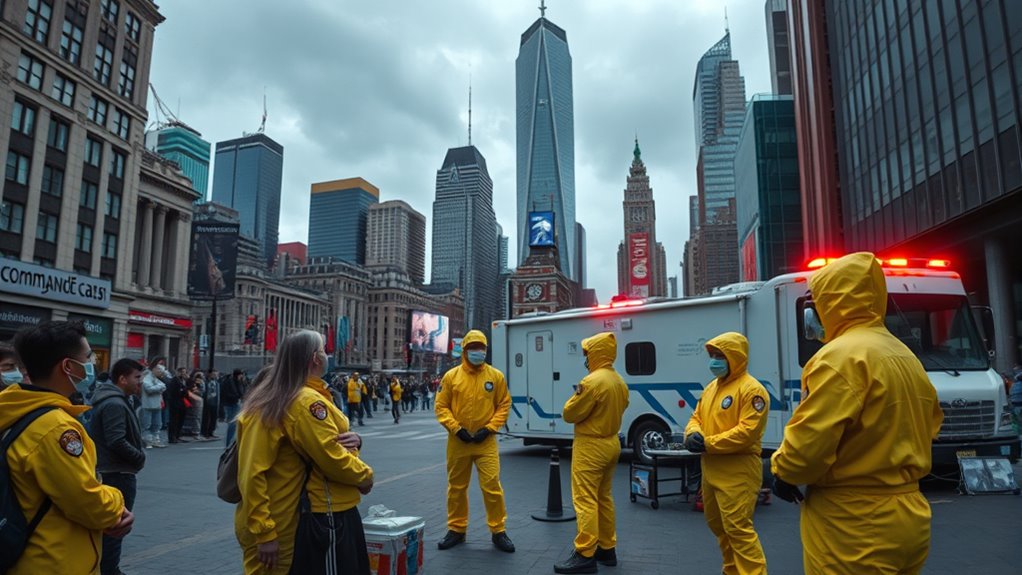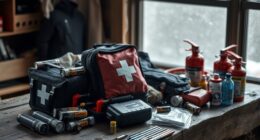Pandemic preparedness drills are starting in major cities around the world. These exercises help guarantee public health officials can respond effectively to outbreaks. By simulating real-life scenarios, cities identify gaps in their strategies and improve collaboration between the public and private sectors. Engaging local communities boosts awareness and compliance with health directives. As these drills unfold, you’ll discover much more about the complexities and benefits they bring to urban pandemic response efforts.
Key Takeaways
- Major cities are initiating pandemic preparedness drills to enhance public health response strategies and collaboration between sectors.
- These drills involve scenario development that closely mirrors real-life pandemic situations for effective management practice.
- Advanced technology is being integrated into simulations to improve real-time response capabilities during potential outbreaks.
- Community engagement is essential, with local populations participating in exercises to boost awareness and compliance with health directives.
- Urban areas face unique challenges, making these drills crucial for efficient resource allocation and international cooperation during health crises.

When it comes to safeguarding public health, pandemic preparedness drills play an important role in ensuring a swift and effective response to potential outbreaks. You’ll find that these drills often involve collaboration between public and private sectors, bringing together experts from various fields. For instance, the Event 201 exercise, organized by the Johns Hopkins Center for Health Security alongside the World Economic Forum and the Bill & Melinda Gates Foundation, showcased this collaborative spirit. By simulating real-world pandemic challenges, these drills help identify gaps in preparedness and refine strategies.
As a participant, you’ll engage in scenario development tailored to mirror real-life situations. This aspect is significant, as it allows you to understand the complexities involved in managing a pandemic effectively. The invitation-only nature of these drills fosters focused discussions, allowing experts to share insights and develop robust strategies. Integrating advanced technologies can enhance your understanding, as some drills simulate real-time responses to pandemic scenarios, showcasing how technology can aid in preparedness.
It’s important to recognize the broader economic and social impact of pandemics. You’ll learn that pandemics can lead to significant economic downturns and societal disruptions. As a result, holistic preparedness strategies are essential. Ensuring supply chains remain operational during such crises is critical for maintaining essential services and stability in your community. Additionally, drills emphasize the importance of social cohesion, addressing potential challenges like misinformation and panic that can arise during outbreaks.
Community engagement is also a focal point in these drills. By involving local communities, you can improve awareness and compliance with public health directives. Role-playing exercises simulate real-world situations, enabling you to practice your response in a controlled environment, which improves your effectiveness in actual emergencies. Feedback loops from these exercises provide valuable insights for refining strategies based on lessons learned.
Urban areas, with their unique challenges due to population density, require specialized planning strategies. You’ll see that case studies of urban pandemic responses offer insights into effective approaches for preventing and controlling outbreaks. Efficient resource allocation becomes significant in these settings, ensuring that public health infrastructure can withstand the stress of a pandemic.
Ultimately, your involvement in pandemic preparedness drills contributes to international coordination, which is important for addressing health crises that transcend borders. By participating, you’re not just preparing your city; you’re also enhancing global cooperation and awareness, making a meaningful impact in the fight against pandemics.
Frequently Asked Questions
How Often Are Pandemic Preparedness Drills Conducted in Major Cities?
Pandemic preparedness drills in major cities are usually conducted annually, ensuring readiness for potential outbreaks.
However, you might notice that the frequency can change based on recent health events or funding availability. Some cities opt for drills every few years, while others increase simulations after significant epidemics.
Engaging stakeholders during these drills is vital, and feedback helps refine future exercises, enhancing overall public health response and preparedness.
Who Organizes and Oversees These Preparedness Drills?
Organizing and overseeing preparedness drills is like conducting a symphony; it requires coordination and expertise from various players.
Local Health Departments lead the charge, acting as communicable disease experts. Emergency Management Agencies provide operational guidance, while international organizations support through exercises.
Private sector consultants help businesses prepare, and community groups pitch in with local resources.
Together, these entities create a thorough approach to guarantee your community is ready for any pandemic scenario.
What Agencies Participate in the Pandemic Preparedness Drills?
Various agencies participate in pandemic preparedness drills. You’ll see the Department of Defense, U.S. Special Operations Command, and FEMA coordinating efforts.
Internationally, organizations like the World Health Organization and Africa CDC join in exercises to enhance global responses.
Local and regional agencies also collaborate, ensuring rapid communication and effective planning.
Are Citizens Informed About These Drills Beforehand?
Yes, citizens are often informed about these drills beforehand.
You might notice announcements through local media, social media platforms, or municipal websites. Some cities even invite residents to participate or attend as observers, enhancing community engagement.
While transparency varies, many cities work to communicate effectively to guarantee that everyone is aware.
However, challenges like resource limitations and cultural sensitivity can sometimes affect how well this information reaches all segments of society.
How Are the Results of These Drills Evaluated?
When the curtain rises on a drill, the spotlight shines on evaluation. You’ll see results assessed through pre-/post-tests to gauge knowledge shifts, while skill-based evaluations focus on practical abilities.
Logistical assessments review resource availability, and communication evaluations analyze team coordination. Feedback mechanisms guarantee continuous improvement.
Ultimately, you’ll find that these measures enhance preparedness, guaranteeing everyone’s ready to face any challenge that comes their way, like a well-rehearsed performance.
Conclusion
As cities gear up for pandemic preparedness drills, you can feel the pulse of urgency in the air. It’s like a fire drill for a storm we hope never arrives. By participating in these exercises, you’re not just practicing protocols; you’re becoming part of a safety net that protects your community. Together, we can weather any storm that comes our way, ensuring that when the unexpected strikes, we’re ready to face it head-on.










